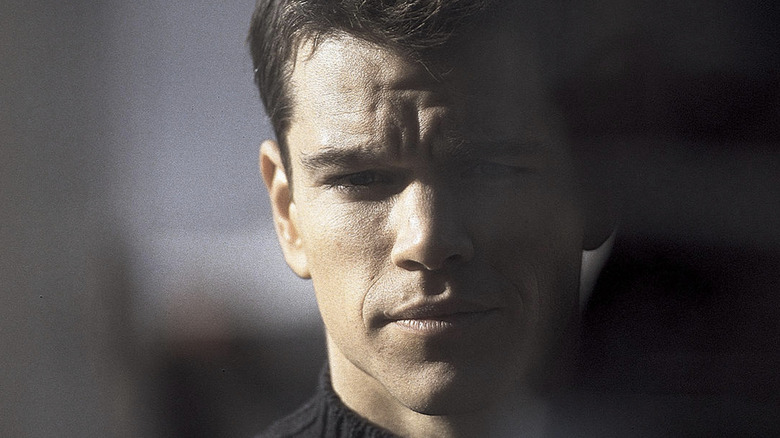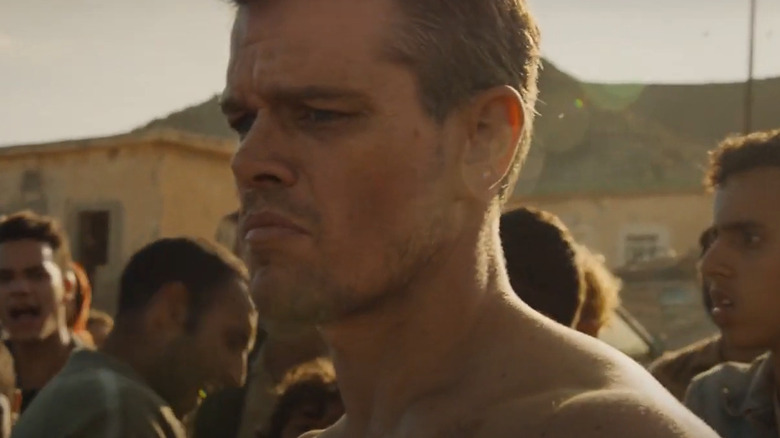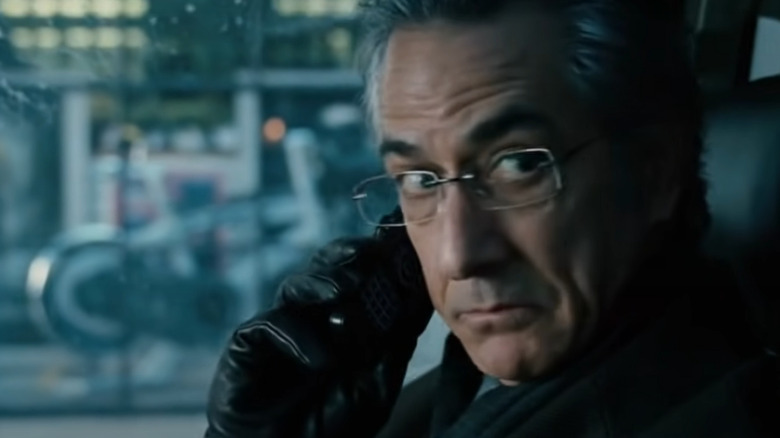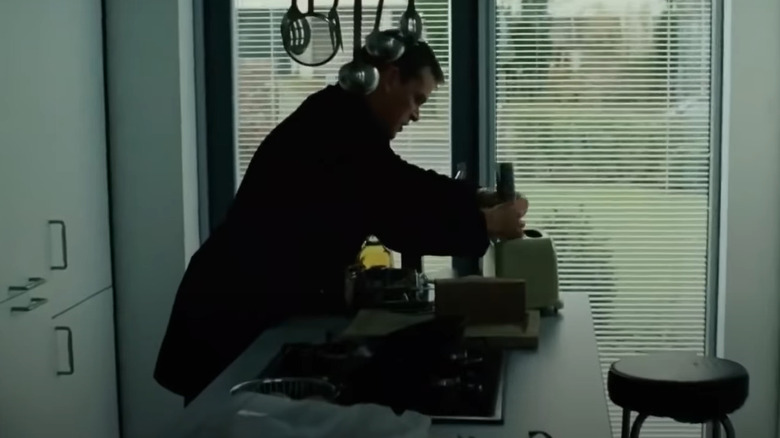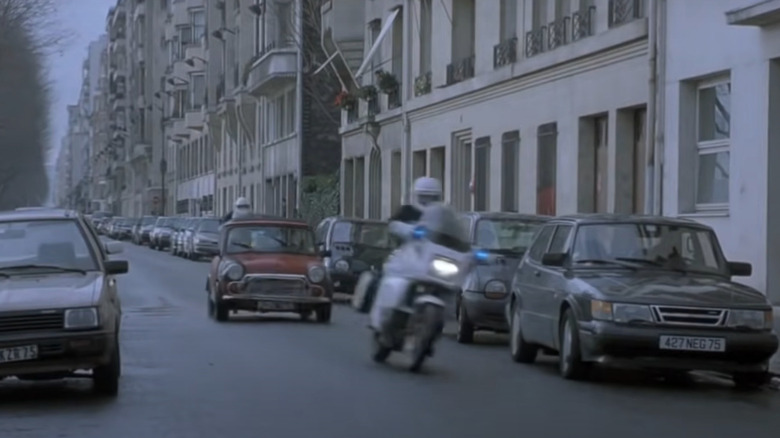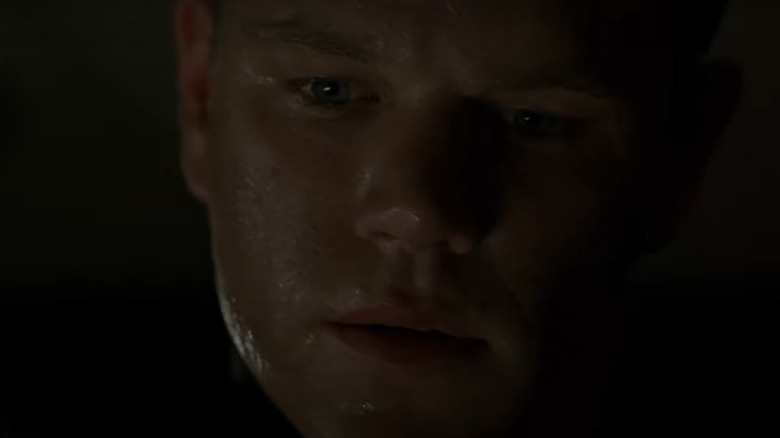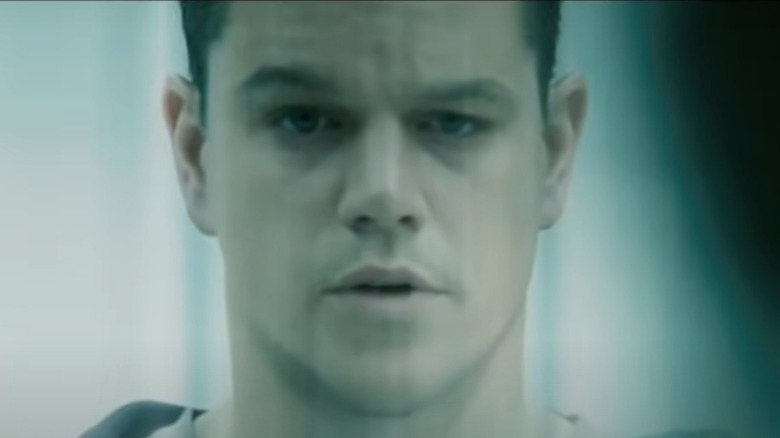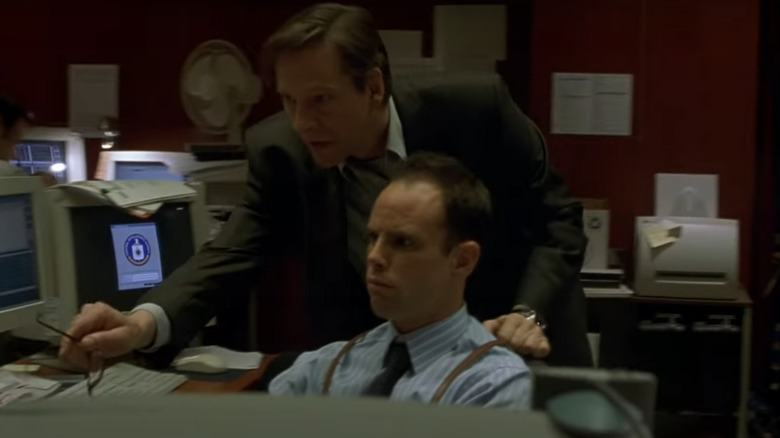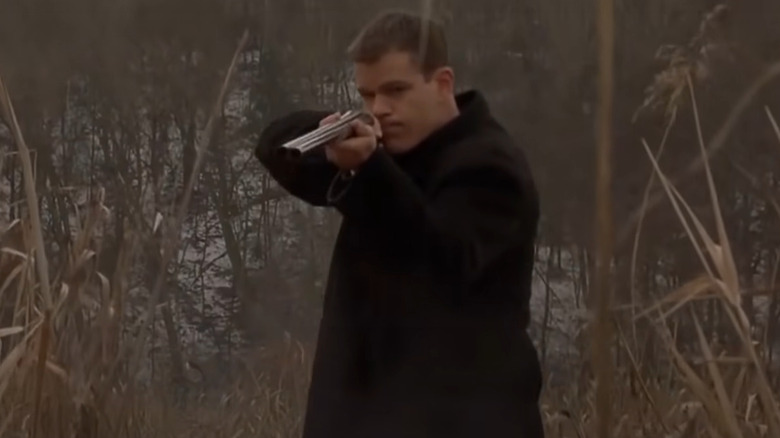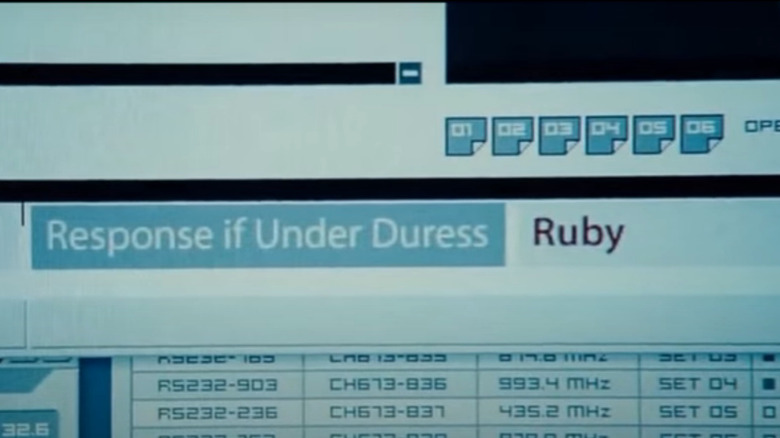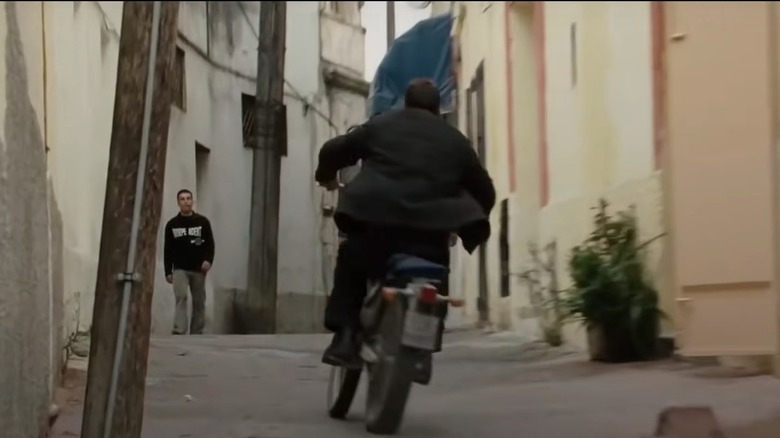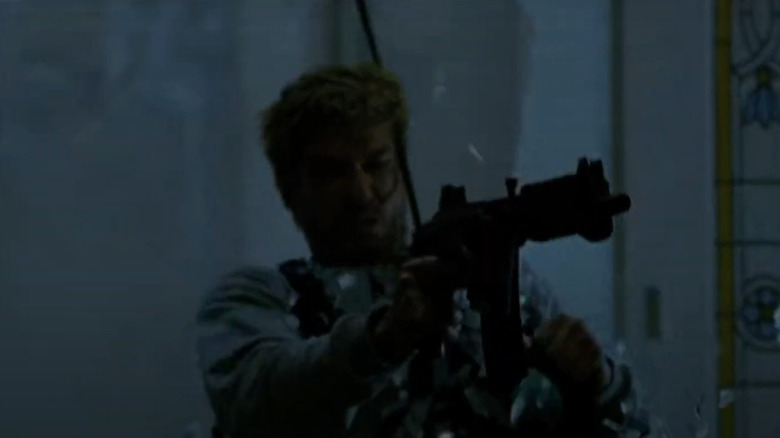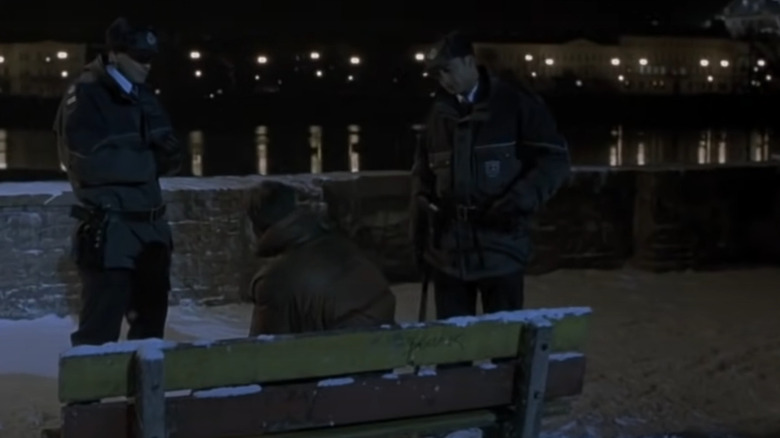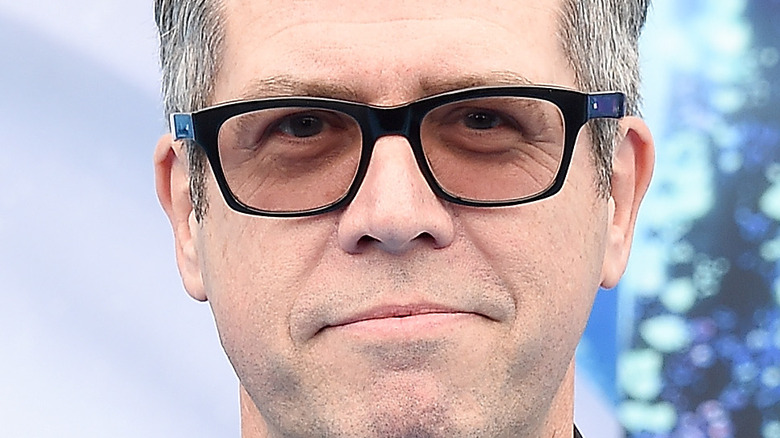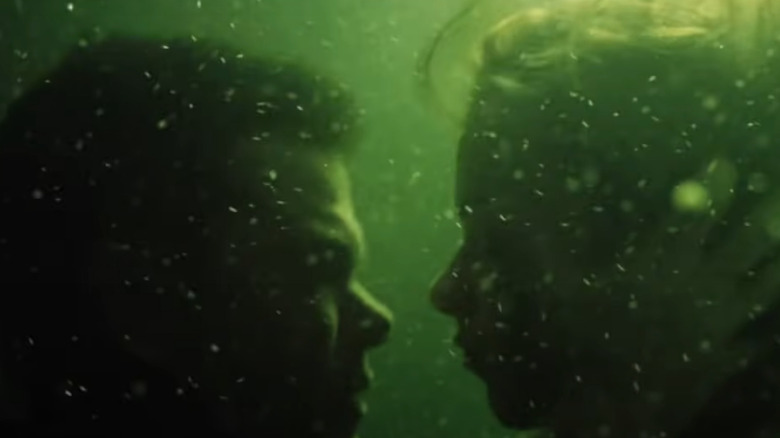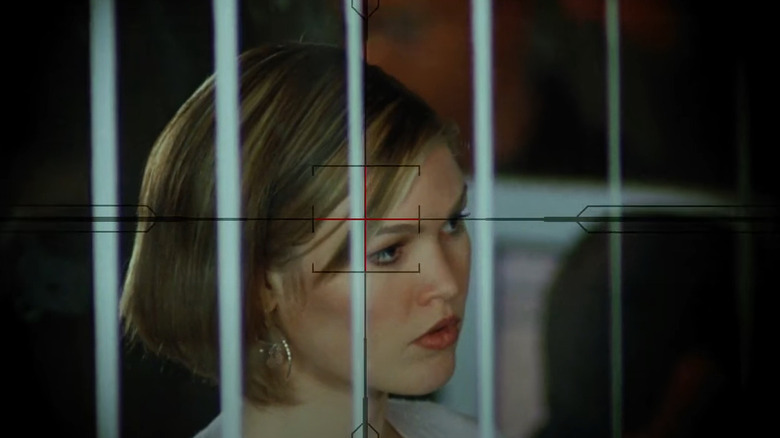Things That Happen In Every Jason Bourne Movie
In 2002, "The Bourne Identity" launched amnesic superspy Jason Bourne into a stratosphere previously occupied only by the likes of James Bond, as the character roared across screens to arguably become the first great 21st Century film hero.
But while fans remember Bourne — inspired by a series of novels from author Robert Ludlum, following an amnesic assassin as he tries to rediscover his own identity — which things happen in which of the 5 films (4 with Matt Damon) and 2 miniseries (none of which had Damon) can be a blur.
While the original trilogy — "Identity," 2004's "The Bourne Supremacy," and 2007's "The Bourne Ultimatum" — remains varyingly beloved among fans, and 2016's revisit "Jason Bourne" is not entirely without merits, when Damon hasn't been on screen (as in 2012's "The Bourne Legacy"), the franchise has had to lean on cliches, not character. Of course, many of these cliches have been present with or without Damon — perhaps, then, it's simply the presence of a 3-time Oscar nominated actor (and 1-time Oscar winning writer) who has helped the material transcend.
Whether you're a diehard fan, or a casual moviegoer who remembers the "Bourne" films as a daunting blur rather than distinctive adventures, here's a breakdown to help explore the tropes of the franchise, and when they worked best.
Bourne remembers his combat training
In each movie, sooner or later Bourne throws down. Fists, feet, magazines, knives, batons and more are dealt destructive fury in each installment. In other words, where there is Bourne, there is kung fu, krav maga, and other variations of hand to hand combat, often unlocked in a time of need by an entrenched knowledge hidden deep in his labyrinthine mind.
Regardless of how Bourne remembers such methods, it's hard to overstate the Bourne franchise's impact on 21st century action movies. In the wake of "Identity," director Doug Liman's methods and techniques were endlessly copied. Suddenly, every action film needed the adrenaline immediacy of shaky Steadicam work (dubbed by many as shaky cam), and every hero (regardless of country of origin) needed to effortlessly blend fighting techniques as if they were a Jamba juice employee whipping up a Razzmatazz.
Liman's camera, edits, and staging created a symphony of swift kicks and punches in the original film, one he would not revisit with Damon as director (fellow shaky cam enthusiast and "Bloody Sunday" filmmaker Paul Greengrass would take over for future Damon installments), but would still nominally oversee as a series executive producer. Baby faced Matt Damon was certainly an atypical action star, yet Liman's documentary-like camera work and strong editing transformed him into one.
Tele-play-acting
Any die-hard fan of the Bourne franchise knows that in a Bourne movie, sooner or later, somebody's picking up a phone. In fact, phone interactions are so central to the plot that the scenes still work, despite the tech becoming dated nearly as soon as the scene was filmed.
The phone call's function in these scripts — keeping Bourne and his antagonists separated while allowing them to communicate, creating a glorious tension — is reminiscent of everything from "Hopscotch" to "Munich." Adversaries connect, yet cannot confront.
In "Identity," Bourne speaks with Chris Cooper's Agent Conklin and Brian Cox's Ward Abbott to set up a final showdown. "I'll redial this number," Bourne says, which feels dated since nobody has "dialed" a phone in a generation. Nonetheless, Damon delivers the line with a level of menace so high, it turns into a convincing threat and good reason for Conklin and company to abandon ship.
Phones are employed throughout the rest of the series to similar effect. Whether Bourne is making a threat or helping the audience through a long exposition dump, chances are it is being done over the phone.
Improvised weapons
Bourne is an interesting character for a variety of reasons. While the biggest draw to the character is witnessing his quest to discover who he is and what he's caught up in, there's also a lot of "MacGyver" in the guy.
In his "Supremacy" review, Roger Ebert said Bourne often gets out of dangerous situations through improvisation and "lateral thinking." While most spies think on their feet (Bond has made do with all kinds of tools and vehicles for self defense and escape) the "Bourne" film are typically edited to display Bourne's thought process (a technique that would undoubtedly influence the Robert Downey Jr. "Sherlock Holmes" films a few years later). The editing and screenwriting is so deft in certain moments that the result is a visual Rube Goldberg machine. The audience has seen the set up, and now they're waiting for the payoff.
Perhaps the best example of Bourne's impromptu weapons-crafting skills crops up in the "Supremacy." Bourne, made aware a team of incoming killers is set to raid the house he's in, rigs a toaster bomb. In a few cuts, the audience sees the process. First, a magazine goes into a toaster, then a gas line is torn open, and finally Bourne starts the toaster. At first it makes no sense, but by time the Bourne turns the toaster to its bagel setting, the audience knows what's coming. Like most things Bourne, the audience is sold on the character's incredible skills through a marriage of clever writing and camera technique.
Road rage
Sooner or later, every Bourne movie puts its hero behind the wheel of a car with a collection of bad dudes in pursuit. No car chase, no Bourne movie.
Like other elements of the franchise, this vehicular violence exists in the thin space between grounded action and completely impossible nonsense. Instead of leaning into the unthinkable (like "The Fast and Furious" franchise), the Bourne films pump the brakes every time things get a bit too surreal — and when they feel too grounded in reality, well, that's when Damon starts driving a taxi backwards through a tunnel while lying down in the front seat so he can shoot out Karl Urban's tire.
Further examples of this tightrope walking occur in the "Sir, he drove off the roof" scene from "Ultimatum"; the best example of what makes a Bourne chase so special, however, likely comes from the blueprint, "Identity."
In the scene, Bourne and Marie (played by Franka Potente) zig and zag through Paris to avoid the police in a retro Mini Cooper. Liman's decision to lean into the Mini's size makes the car chase unlike anything that came before it. Upon the film's release, it was instantly hailed as being worthy of a spot alongside the landmark car chases of films such as "Bullitt," "The French Connection" and "Ronin."
Instead of simply slamming into other cars, or barreling down straightaways at ludicrous speed, Bourne uses the Cooper's size and shape to his advantage. He drives it on the sidewalk, through narrow alleyways, throws it down cobblestone steps, and finally gets away by causing a small scale pile up. The scene is as impressive in its skill as it is in its restraint.
Quick trips to the past
While the action in these films is almost always straightforward — Bourne battles the CIA and dirty wet work teams — their narrative thrusts are often complicated. The series revolves around a central mystery — who is Jason Bourne, really? — and each film is marked by a single mystery unearthed.
Diving into the nitty gritty details would take an entire essay, but each movie does revolve around its own unique mystery within the greater puzzle of Bourne's identity. These films leverage the same narrative device to relay complicated information to its audience quickly: the flashback.
The movies wisely never overstay their welcome in the past. Instead, flashbacks rip onto screen during various pivotal plot points to quickly extrapolate Bourne's often tragic past. The flashbacks are not only economical because they take up so few minutes, but also because their revelations are immediately relevant to the plot. They either deepen the mystery or significantly change the outcome of a given situation. In a world where some episodes of TV have entire flashback episodes to simply say "this character is bad," the Bourne movies take mere seconds to color in details.
The smolder
Matt Damon — obvious though it may appear now — was something of a casting gamble. Until the Bourne franchise, he had starred primarily in indie movies ("Good Will Hunting," "Dogma") and large dramatic vehicles ("The Rainmaker," "The Legend of Bagger Vance").
Today, actors of all backgrounds play action heroes (look no further than "Nobody," which gave viewers a butt-kicking, hand-to-hand-savvy hero played by ... mid-50s comedian Bob Odenkirk?), but action stars of the '80s and 90s predominantly stayed in their lanes. Credit Liman, who felt Damon could be a convincing action figure.
"In Matt's hands," he told The Hollywood Reporter in 2022, "I could give Bourne a really dark past and you would still root for him."
Liman's assumptions panned out, and the Bourne franchise minted Damon's status as the action star next door. They also gave audiences four films built around Damon's signature "pouty face." Whether Bourne's peering down a sniper scope or choking out an assassin with an extension cord, the Bourne movies present everything with a unique attitude that when, say, Jeremy Renner tried to duplicate in "The Bourne Legacy," the magic simply wasn't there.
Situation rooms
The men and women pulling at Bourne's strings are all colored in well enough to ensure the shadowy folks behind the scenes never turn into an indiscernible blend of deep state ne'er do wells. There is one thing each baddie who wants Bourne's head does have in common: they love themselves a situation room.
It's a franchise staple. A generic conference room, or office, or hotel business suite, is flooded with CIA analysts, computers that whirl, beep, and "enhance" images perfectly with the click of a space bar (any photo editor will tell you that's not the case), and phones. Cellular or landline, as long as it can be dialed and shouted through, it belongs in a Bourne situation room.
While the idea of a shadow organization like the CIA wantonly invading Marriott Moscow's business suite and turning it into a command center unnoticed does feel inherently silly, it also adds to the charm of the franchise. Plus, its ripple effect has shown up in other movies long since the initial franchise kicked off the trend. Today, any spy or assassin movie worth its salt needs to have at least one scene where a villainous suit stares at a room full of lackeys sweating over grainy footage and shouts: "Enhance!". Inventing a genre staple is no small feat.
Shoot outs
Fisticuffs, car chases, and magazine roll knife fights aren't the only type of action in the Bourne franchise. Any Bourne worth the cost of its cellular international roaming fees needs a good shootout.
However, shootouts in the Bourne movies aren't the gun-fu or pistol-jitsu of "Equilibrium" and action franchises like "The Matrix" or "John Wick." Instead, like most things the series does, its shootouts are quicker, weightier, and a bit nastier. In other words, if it only takes Bourne a few minutes to dispatch CIA stooges with his hands, all a gun does is exponentially expedite the process.
For example, in the "Bourne Identity," Bourne engages with Clive Owen's asset — called The Professor — in a field in the French countryside. Both trained killers know the other is nearby, but neither know how close. Eventually, Bourne uses bird movements to draw his assailant out before downing him with repetitious blasts from his shotgun.
It's a grisly little scene. It focuses on basically everything except the gun in Bourne's hand — setting, sounds, and lighting — until it doesn't. Jason shoots The Professor and then it's simply over. Bourne, so devastated upon discovering he's actually a deadly assassin a few scenes earlier, has turned into a manhunter when threatened. The duck rifle and the countryside not only nail the lid on the scene's metaphorical coffin, but also become a template for the weight the Bourne franchise gives to non-improvised weapons. Deadly, noisy, and efficient.
Spy jargon
Much like the situation room so many scenes transpire in, most of the Bourne franchise's dialogue is spoken in what can best be described as "spy jargon." Covering a range of terms and phrases from Treadstone's assassins, referred to as "assets," phrases are sprinkled liberally throughout dialogue, including but not limited to "secure line," "code in," "response: [insert code word here]" and more, all tossed around like hotcakes at a pancake eating contest over the course of the series.
A special shout out to the franchise spin-off, "Bourne Legacy” and Edward Norton's Colonel Eric Byer for describing assets as "sin eaters," as in a group of government agents who are "morally indefensible and absolutely necessary."
While leveraging jargon to immerse an audience in a given industry is tricky to pull off, the Bourne screenwriters do so with aplomb. They avoid jargon traps like audience confusion over unfamiliar words. They also don't render the movie's dialogue rote because each phrase and term is backed up on screen by a recognizable reaction. The first time Bourne is asked to "code in" in the "Bourne Identity," the officer's pause after the question lets the audience know Bourne's expected to speak in response. Neat alignments of dialogue and editing like that is part of what makes the Bourne movies so special.
The one-man traveling demolition crew
Unlike some action franchises, the Bourne series makes its iconic settings a key part of the plot. Consider recent movies like "The Gray Man" and "Ava," both action-powered films that name-droop locales, but give you all the local flavor of a 2-hour layover where you don't leave the airport. The "Bourne" films, on the other hand, finds ways to use features of its locales to influence its action.
The narrow streets of Paris become a maze for Bourne to weave through in "Identity"; Berlin's enormous public square "Alexanderplatz" becomes the perfect cover for Bourne's escape in "Supremacy"; the narrow laneways and rooftops of Tangiers create an embarrassment of ramps, jumps, and stunts for a rich motorcycle chase in "Ultimatum."
Naturally, Bourne can't visit any of these marvelous cities without leaving a trail of wanton description in his wake. Whether it's pile ups, broken glass, locks, windows, or walls he's smashing, Bourne is such a rude tourist that you have expect him to walk into a restaurant and order a local delicacy ... and a bottle of ketchup.
Assets are activated
No matter what other problems Bourne may face, sooner or later he'll run into another asset. Like him, the assets are super trained, super lethal, and super indiscriminate when it comes to executing folks under orders from the boss.
Some series standouts include the blonde haired, cross sweater rocking, and window breaking assassin from the first film in the franchise, Karl Urban ("The Boys"' Billy Butcher himself) as Kirill, and Vincent Cassel, literally monikered "The Asset" in "Jason Bourne."
These characters work to raise the stakes of action. More often than Bourne moves through human obstacles like they're Swiss cheese, however, the assets level the playing field a bit. Sure Bourne always wins in the end, but it's no less fascinating to see how. In fact, Bourne's confrontations with opposing assets are often the high points of the movies.
Such showdowns not only lend an excuse to launch into fantastic action set pieces, but also create drama for the movie's protagonist. As much as Jason Bourne would like to get free of his past life, at one point or another, he is the man on the other end of Blackbriar's phone calls. He's figuratively fighting himself.
Poor PR for police
In Bourne's travels throughout Europe, sooner or later he's going to encounter a group of local peace officers. Without fail, these interactions always wind up overcoming a squad of international boys in blue.
In the early movies, Bourne's interactions with law enforcement quickly introduce Bourne's deadliness to the audience. Consider his skill showcase in "Identity," when two hapless Swiss cops come across Bourne sleeping on a bench. After trying to place Jason under arrest, the super spy quickly dispatches the two officers with their own batons. Quickly is the operative word, since Bourne moves through these poor guys in a matter of seconds.
As the series continues, law enforcement generally winds up as fodder for car chases or blank bad guys who increase the pressure on Bourne simply by being warm bodies. However, it's not only international police departments that get the short shrift; the NYPD tries to take down Bourne in "Ultimatum," and it goes about as well as one might expect.
Powell's pulsating score
Oftentimes, when it comes to memorable franchises, fans overlook the score. Although you don't often hear talk of the "Bourne" music ranking among the best soundtracks, the series simply wouldn't have become the massive success it did without the work of composer John Powell.
Powell created a sound that defined the action genre for a moment, and still rears its head in movies today. Powell's minimalist approach — to a genre that had been scored by enormous sounds like operatics in John Woo films or big horn sections in the original 007 films — impacted everything. From the "Fast and the Furious" movies to "John Wick," minimal scores have since become the name of the action game.
In a 2017 interview with Den of Geek, Powell said he landed on Bourne's minimalist sound when Liman said he was hoping to make the "anti-Bond." Powell has since publicly stated he's no longer interested in working on films that glorify violence, and has instead turned his talents to films like "Happy Feet," "Rio," and "How to Train Your Dragon." While fans can surely respect such a decision, his ear for the genre is missed.
Bourne takes a dip
For some reason, in each iteration of the franchise water ends up playing a part. Perhaps it was initially Liman's idea, maybe Greengrass had an interest in shooting in water, or perhaps screenwriter Tony Gilroy thought water would function as the perfect metaphor for a form of rebirth.
In "Identity," Bourne's body is dumped in the Mediterranean after a botched assassination attempt kicks off the franchise. Later in the same entry, a post shower hook-up with Marie indicates Bourne's desire to be a regular human (and not a weapon). In "Ultimatum," Bourne falls into the water at the film's conclusion to escape his pursuers.
"Supremacy," however, delivers arguably the most haunting shot of the entire series. After Bourne's love interest from the first film is shot in India, Bourne looks at her body under the water. Slowly, Marie drifts away and becomes more and more unrecognizable until she eventually, literally fades out of Bourne's life forever. Then, Bourne emerges from the river with a new purpose: revenge. It's an incredible shot — and further evidence of water's thematic importance to the franchise.
A stellar supporting cast
The Bourne franchise's reliance on character actors in antagonistic and supporting roles has always been a strength. The list of supporting appearances reads like a who's who of the best guns for hire from the '00s: Brian Cox, Chris Cooper, Clive Owen, Adewale Akinnuoye-Agbaje, Franka Potente, Walton Goggins, Karl Urban, Joan Allen, David Strathairn and Scott Glenn among them.
While readers may recognize some names and not others, the Bourne movies are also improved through big name actors in smaller parts. Albert Finney shows up to incredible effect in "Ultimatum" and Edward Norton basically walks off with "Legacy."
But a special shoutout should go to Julia Stiles, who appears in every episode of Jason Bourne's story as Nicky Parsons, somehow building a strong character with frequently few scenes in the film, predominantly behind some sort of keyboard. Stiles was momentarily an it girl in the early 2000s following "Ten Things I Hate About You," but as Nicky, Stiles' warmer sensibilities make her a fine moral compass for Bourne.
While Matt Damon will forever be seen as the face of the "Bourne" franchise, it would be nowhere without the talent of such supporting stars. Perhaps, it seems, Jason Bourne isn't as alone as the films often make it appear.
